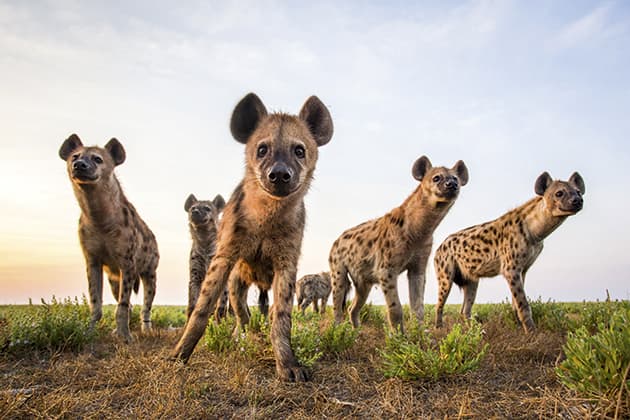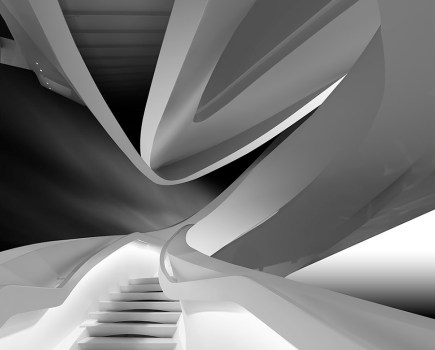Although Will Burrard-Lucas has built a firm reputation as a wildlife photographer, he was something of a latecomer to photography. ‘I guess I got into it fairly late, when I was at university,’ he explains. ‘That coincided with the advent of affordable decent-quality digital cameras, particularly digital SLRs. It was about the time that the Canon EOS 300D first came out. I got that camera in about 2003, because I really love travelling, and through my university holidays I tried to travel whenever possible. So I got the camera just to document my travels.
‘I loved the photography side of things, and that led to me figuring out how to take better photos and determine why some worked and others didn’t. It was just learning through a process of trial and error. I’d had film cameras before, but without that instant feedback on the back of the screen the learning curve was just so long between taking a photo, fiddling with settings and having to wait for films to be developed so you could see what you’d done. Digital definitely facilitated me getting into it, improving and progressing.’
Why wildlife?
Will’s desire to document the natural world came out of a childhood that was spent partially in Africa. ‘I’ve always had a fascination with wildlife and the natural world,’ he says. ‘Between the ages of seven and ten we lived in Tanzania because of my father’s work. Some of my earliest memories are of being on safari, and when I was growing up our family always enjoyed travelling to see wildlife. Gradually, in the years that followed, the focus of my trips became more about photographing the things I was seeing rather than just looking at them. That’s how it happened organically – it was a sort of ‘meshing’ of my interests, specifically, my love of the natural world and my absolute passion for the art of photography.’
Perhaps unsurprisingly, Will names the BBC documentaries about the natural world hosted by Sir David Attenborough as ‘far and away’ his biggest influence, but on the stills side of things he holds the coverage of National Geographic in high esteem.
He adds: ‘The way some of these in-depth National Geographic projects… like those of Paul Nicklen, Nick Nichols and Steve Winter, who are really able to go deep into an area and get a groundbreaking set of images, not just the odd image… photographically speaking those would be my biggest inspirations.’
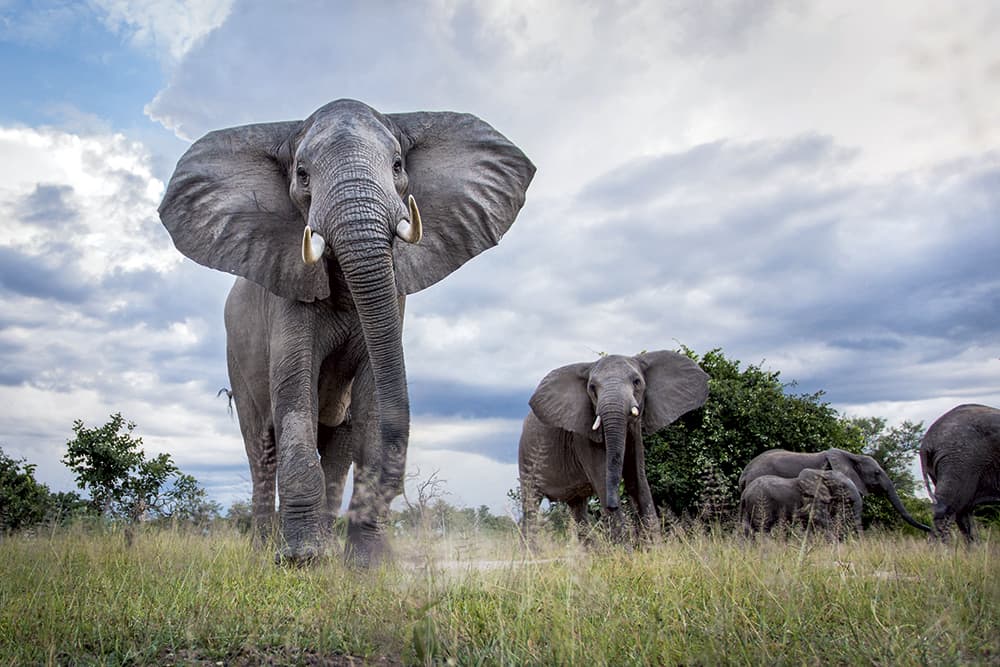
Elephants, South Luangwa National Park, Zambia. Canon EOS 5D Mark III,17-40mm, 1/200sec at f/4, ISO 400
Remote camera set-ups
In recent years, Will’s photography has deliberately focused on getting as close as possible to wildlife and developing his own line of products that have helped him to do so. He reveals: ‘As I was building up the line of products, I started putting stuff online, trying to produce stuff that would get noticed and developing my style. One of the things that appealed to me was this close-up wideangle perspective that is kind of rare in wildlife photography, particularly at a time where you’re used to seeing telephoto shots with a narrow field of view and a shallow depth of field.’
Will adds: ‘If you can get close, wideangles let you see a lot more of the background and you’ve got a perspective that almost feels like the animal is coming out of the frame towards you. I had experimented with it by crawling up to certain creatures that weren’t very threatening – things like penguins and meerkats that weren’t going to trample or maul me to death. I liked that perspective and it was something different but, in the back of my mind, I was thinking it would be really cool to be able to do this with some of the big charismatic creatures in Africa, like lions and elephants.’
Instead of crawling towards wildlife, the obvious solution for Will was to develop a contraption that got close to the animals but that he could be in control of. The first invention was his so-called BeetleCam, which ‘really came from me just sitting down and thinking of the obvious solution… putting my camera on a remote- controlled buggy,’ he says. ‘So, I built it, booked a trip to Tanzania and it worked out. I managed to get the images I’d hoped for, and when I brought them back and showed them to people, they were very widely published and well received. So I knew there was merit to this idea. Over the years I’ve honed the concept and pushed it much further in terms of the sort of photos I’m getting with it.’
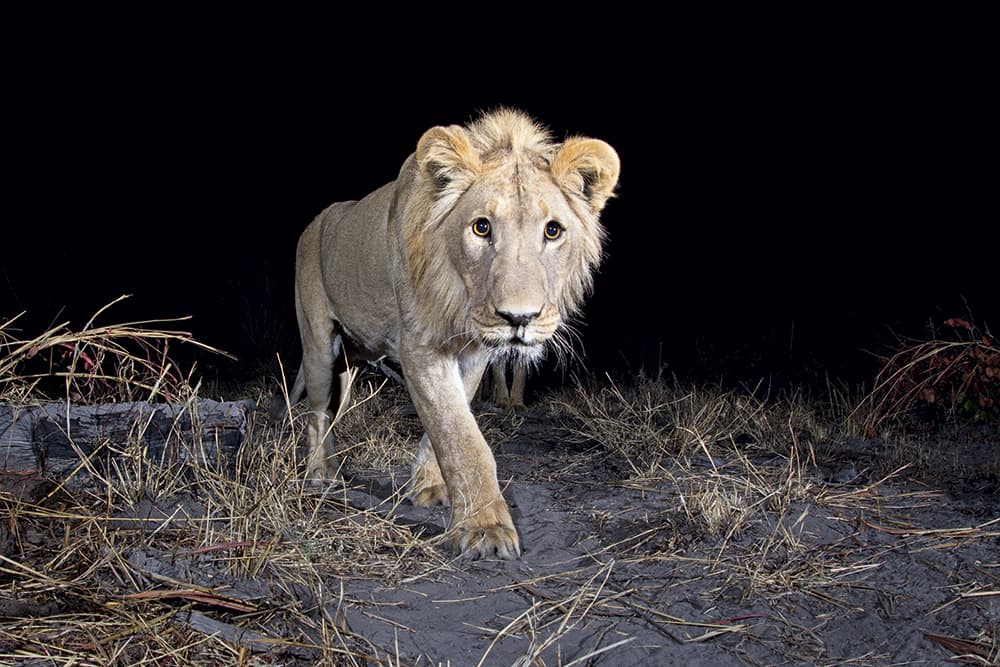
Lion, Zambezi Region, Namibia Canon EOS 700D, 15mm,1/200sec at f/8, ISO 800, Camtraptions PIR trigger
Working with the BeetleCam buggy
Will’s initial BeetleCam was ‘pretty basic’, but the concept has now been developed and includes features such as a tilt option and a live video feed. Typically, Will says he gets to ‘within 30 or 40 metres’ of his subjects and then deploys the camera buggy. ‘What I do is I have a little “minicam”, which is mounted literally bang below the DSLR’s lens and that’s the video feed I’m seeing back,’ he explains. ‘I can use that to compose and check that there’s nothing like grass in front of the lens, and make sure that the animal is roughly where I want it to be.
‘I set it up beforehand and I let the camera autofocus – usually I’ll have all focus points selected and I’ll know, so long as my subject’s reasonably central and is the closest thing, that it’s going to focus on it. I’ll usually set a minimum shutter speed because I don’t want any motion blur if the animal moves a bit. I’ll set a minimum shutter speed and if I need a bit more depth of field I’ll stop down a little and maybe use auto ISO to then do the exposure.’
Will triggers the shutter remotely. ‘I’ve got a switch on the controller – you go in through the same receiver that controls the buggy, but one of the channels is then dedicated to [triggering the shutter],’ he says. ‘Basically, it’s simulating pressing a shutter release on the camera.’
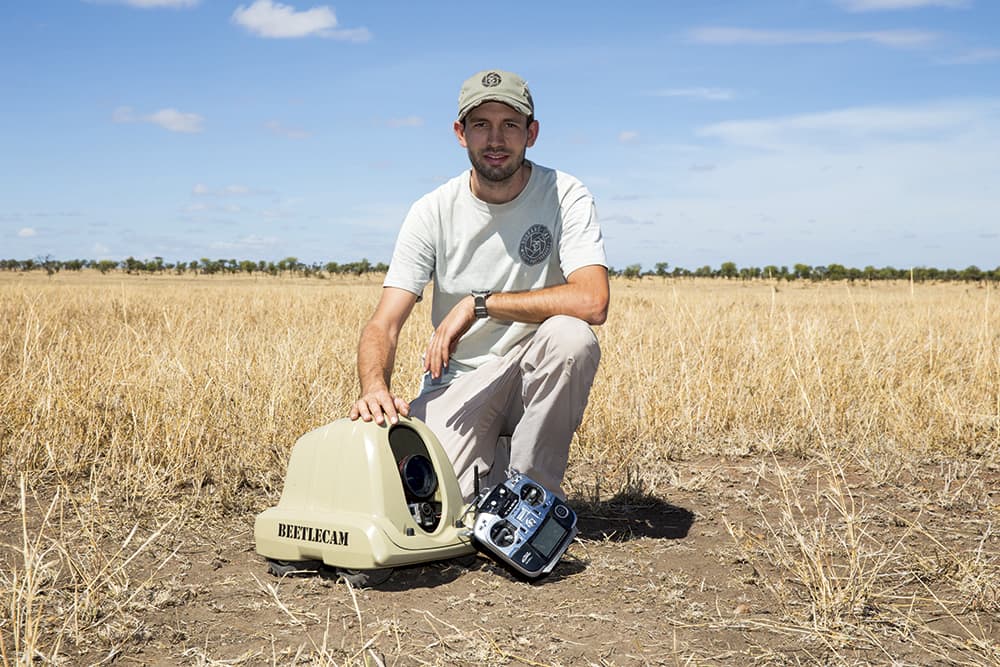
Will Burrard-Lucas with his own personal invention – the BeetleCam
Cameras and lenses
As for the equipment that Will uses out in the field, he states: ‘Canon is my go-to stuff. I use a Canon EOS-1D X (I’m going to get the EOS-1D X Mark II before my next trip), while a 400mm f/2.8 prime is my favourite lens. Unless it’s a project where I know I’m going to need more reach than that, I will use this lens. In Africa, with the size of the animals and how close you can get [to them], 90% of the time this is what I’ll use.’
Will continues: ‘I’ve got a whole load of other stuff – cameras for BeetleCams and camera traps, usually EOS 700Ds up to the EOS 6D and sometimes the EOS 5D, and then wideangle lenses and a 70-200mm. Out in the field I’ll use Sony for some wideangle stuff – for landscapes and maybe behind-the-scenes shots – but it is a bit of a hassle having different lens systems.
I’ll never be taken away from the Canon telephotos and things. I have other things like GoPro [cameras] and the Samsung 360 camera that’s just come out. I’ll try all these new technologies, and if there’s a project where one of them is going to be better I’ll certainly use it rather than the Canons. I’ll use whatever’s best for the job!’
Will admits that he has to keep abreast of the capabilities of most of the major camera brands for his products, which include his Camtraptions range of camera traps for fellow wildlife photographers. He reveals: ‘My plan, in 2013, was to set up a company to build BeetleCams, but actually my bigger focus has been camera traps. BeetleCams are quite a niche product, but there are a lot of people getting into camera traps and [now] my main focus is on the camera trap products.’
Having now developed a ‘second generation’ of his camera traps, Will explains what’s next on the agenda: ‘Over the next few months I’ll be releasing these new camera traps. Thereafter, I don’t think I’m going to need much more development of them because I’ve already honed the design that I think is going to have some good longevity.’
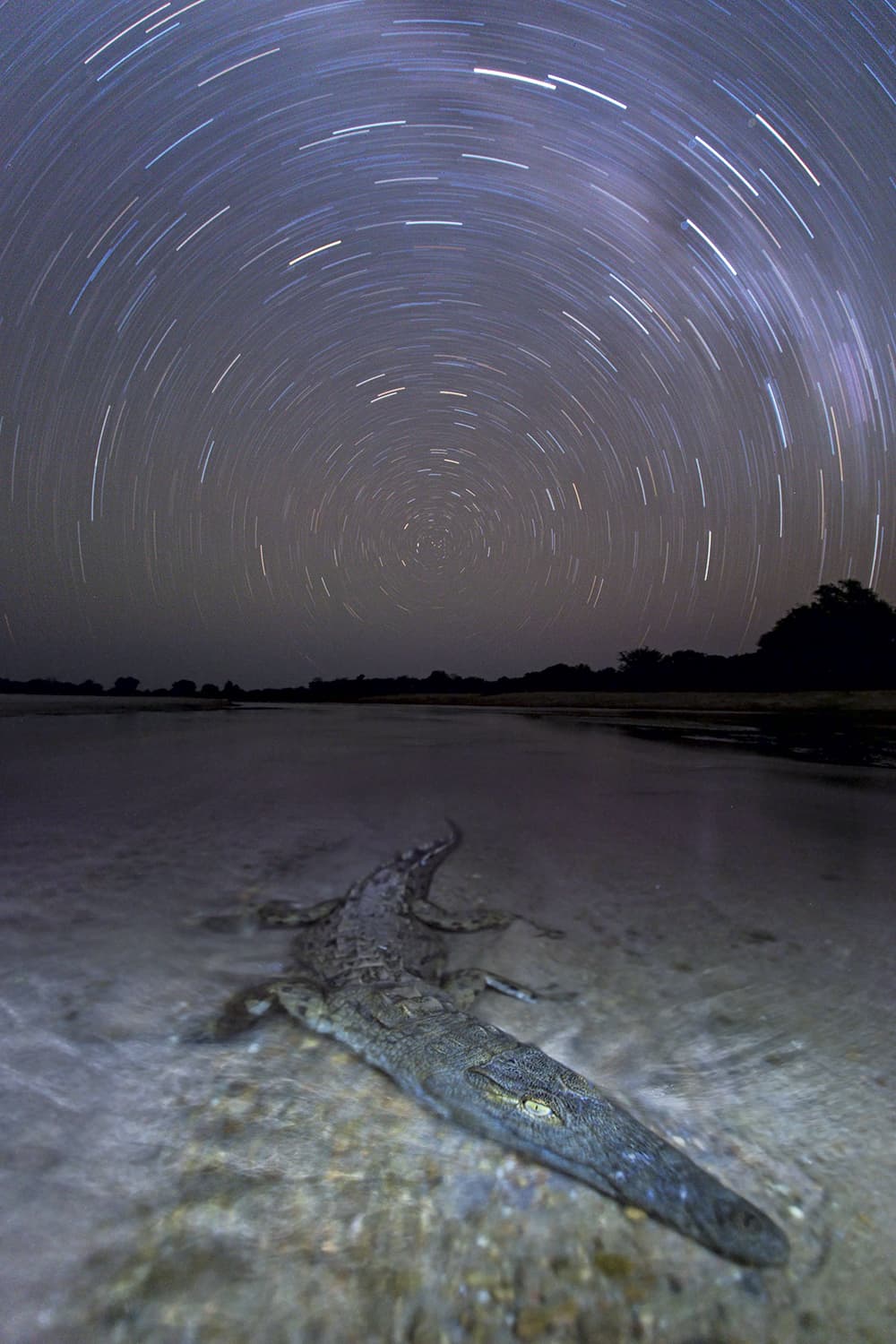
Crocodile, North Luangwa National Park, Zambia. Canon EOS 5D Mark III,17-40mm, 1,024secs at f/4.5, ISO 320
Camera traps: a lazy approach?
In the past, the use of camera traps might have drawn accusations of being a lazy way to photograph wildlife, but Will rebuffs this. ‘I get that less and less,’ he says. ‘In the early days, maybe, there were people thinking that, but the fact is you’re still composing a shot, you’re still lighting a shot, you’re still modifying the camera settings – all those steps that go into taking a photo are still there. The only thing is you’re not pressing the shutter; you’re just waiting for the animal to trigger the shutter itself. I think all the disciplines and the artistic side of photography are still in the camera-trap area – it’s just in a way much harder because you really have to foresee every eventuality and predict almost anything. So it is a really difficult form of photography.
‘All the easy subjects to photograph, such as lions, have been done for years and years, and now people are looking at ways to photograph those more elusive or rare animals or nocturnal creatures that have really been neglected. So obviously camera traps allow you to set up the lighting to get these animals.
‘The other thing is just the scalability of it. With a traditional photography project you’re the photographer and you’ve got to sit there all year, and whatever you see in that time is what you come back with. But now with camera traps, if you’re able to invest in 20 or so, you’ll have 20 out there working for you 24 hours a day and you can be somewhere else. It really allows photographers to increase their output, and from a photo story you can just get another level of images because you’ve been able to leverage your time in that way. You’re no longer limited to being one person with one camera.’
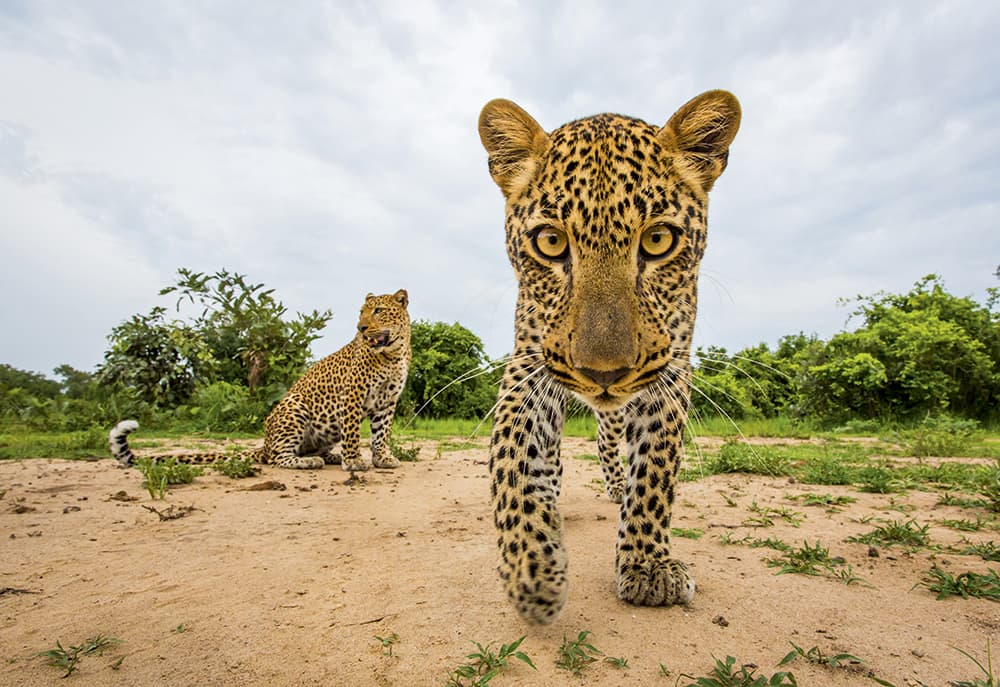
Leopards, South Luangwa National Park, Zambia. Canon EOS 5D Mark III, 17-40mm, 1/200sec at f/11, ISO 800
Post-production workflow
As for the images he produces from his BeetleCams and camera traps, Will explains: ‘I’m shooting in raw and taking them into Lightroom. I adjust all the normal stuff – levels, contrast, saturation, colours and localised dodging and burning. Definitely every photo will be worked on in Lightroom, but it’s not a case of compositing or putting in or taking out animals. It’s generally global adjustments and dodging and burning.
‘If you post a photo that’s maybe flat on social media versus a photo that “pops”, there’s a massive difference in terms of engagement. For that last step there are maybe a lot of photographers who do feel it’s cheating or something, but it’s 100% necessary. You’re really shooting yourself in the foot if you don’t go that “last mile”. Get the image in a state where it grabs the viewer.’
When quizzed about what he tries to convey in his images, Will says: ‘I like introducing my audience to animals to try to get them to appreciate animals. I guess it’s to educate people to see the beauty in animals. To be inspired, enthused and hopefully, to make a small difference in the way people think about animals, so maybe they’ll want to go and do something to help a conservation cause. Definitely, it’s about inspiring people to take notice and to find an appreciation for these animals that I love… and hopefully to make a bit of a difference that way.’
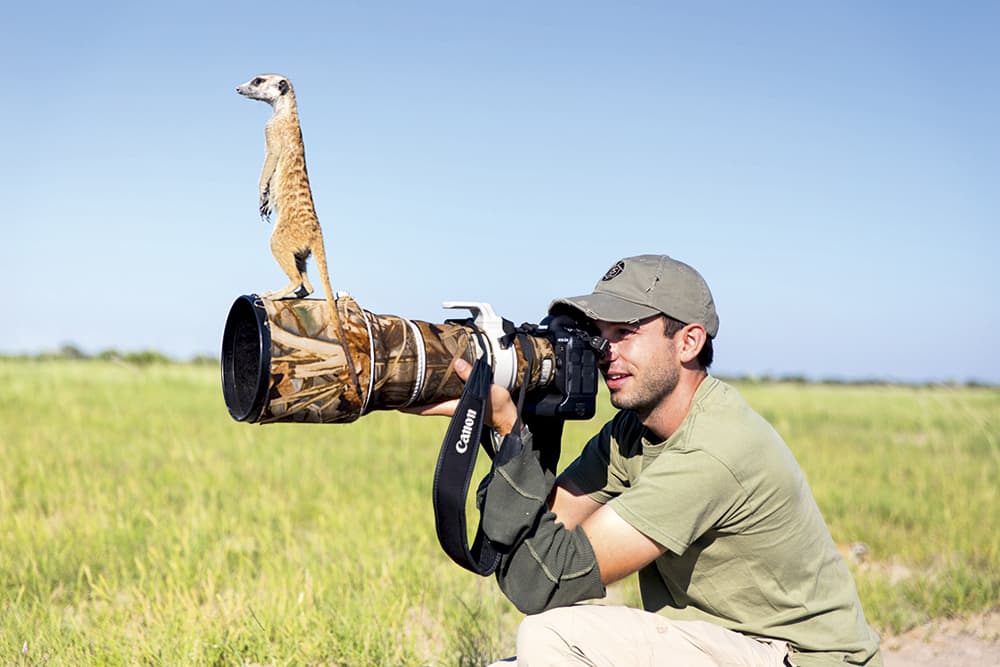
A meerkat takes advantage of the situation as Will shoots in Botswana
Advice and motivations
Taking his career experiences into account, what would be the best advice that Will can give to aspiring wildlife photographers? ‘It’s so difficult if you can’t focus on something you can own and produce something so in-depth that it is unrivalled,’ he says. ‘If you try to compete with all the established photographers just by photographing the same things as them, then you’re not going to stand a chance. By really owning something different, that maybe hasn’t been focused on before and doing that better than anyone else, or in more depth than anyone else, that’s the way you can really progress in this industry. Also, in this day and age, being able to market yourself and use the internet is important because I don’t think you stand a chance if you don’t really embrace that and use that to magnify your reach.’
As for his key motivations, Will reveals: ‘On the photography and travel side I just love being out exploring wild areas and being face-to-face with wild animals – that’s when I really feel alive. I’m quite lucky that I can split my time between being out, away from it all, in the wild, and then running what’s basically a start-up with all the marketing that goes into that.
‘I couldn’t choose between the two, and it’s this combination of having both that makes me tick. It leads to challenges, because running a business when you’re cut off in the wilderness is pretty challenging. It’s not been the easiest path, but I wouldn’t give up.’ For those who have seen Will’s pictures or who have used his products, this is probably a very good thing!
Will Burrard-Lucas is a wildlife photographer from the UK who decided to get closer to wild animals by inventing products for remote and camera trap photography. He specialises in photographing African wildlife and has partnered with a number of conservation organisations to help fundraising. He also teaches an online course and runs photographic safaris. Visit www.burrard-lucas.com.

